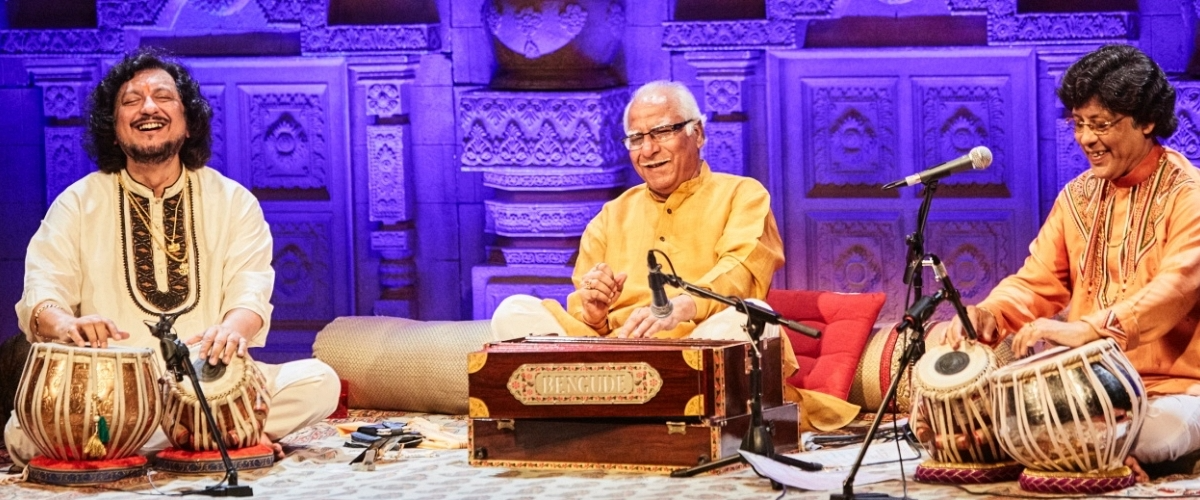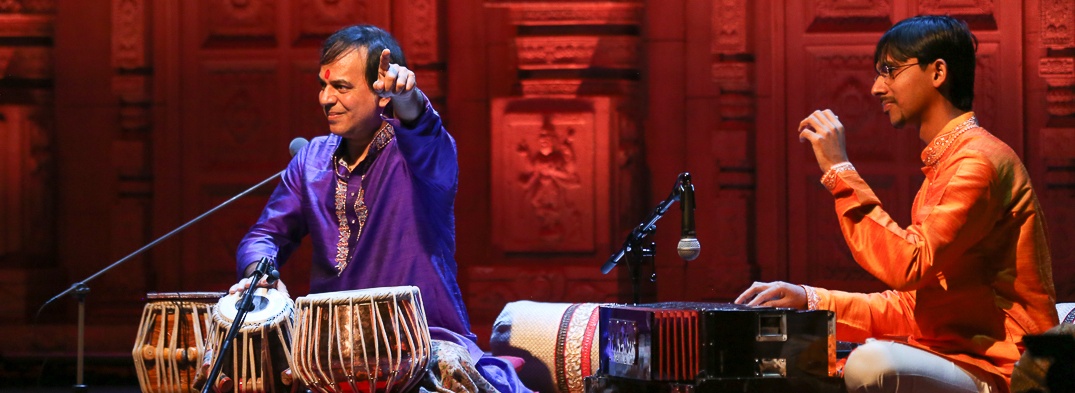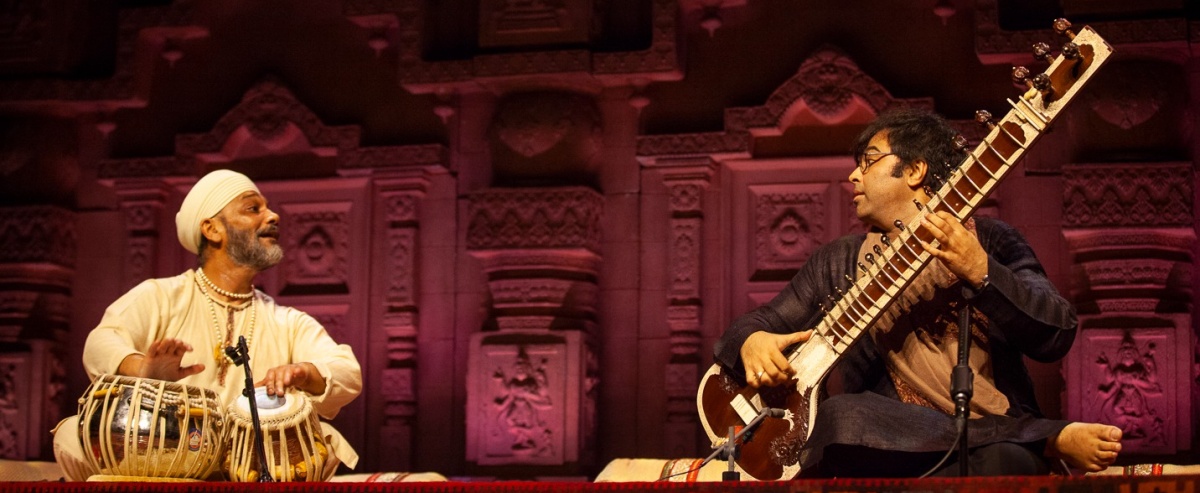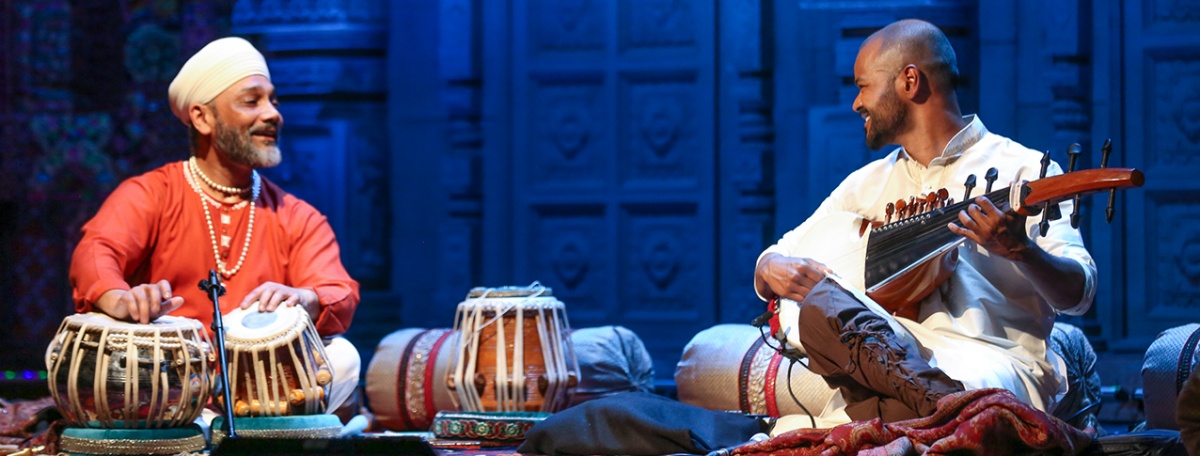

Exploring classical tabla's angular rhythmic resolutions, and examining why patterns of three have such a distinctive power to tell concise stories in music, art, and literature.
—Part of Living Traditions: 21 articles for 21st-century Indian classical music
Hindustani classical percussion blends the architectural with the playful. Newcomers are often struck by the unique marriage, expressing surprise that dense mathematical interplay can feel so fun. Tabla players perplex the listener, unfurling long, intricate structures of tension and release before resolving hard onto the sam (one-beat). They toy with the audience, dragging them away from the main cycle and then returning emphatically.
The idea of tihai is central to this. Literally meaning three times , it describes the phenomenon of thrice-repeating a rhythmic phrase so that the final stroke falls on the first beat of the underlying tala (rhythm cycle). As with most theoretical concepts, it doesn t mean much unless we can hear it. So before we go further, let s listen to some tihai in motion.

Sanju Sahai playing solo at Darbar 2018. Photo: Rehmat Rayatt
1 - Pandit Sanju Sahai uses a classic rolling tihai to announce the start of a solo in madhya laya tintal (medium tempo 16-beat cycle). The repetitions step confidently towards the one-beat in a straight line:
2 - Global tabla ambassador Ustad Zakir Hussain scatters his soloing with all manner of divine tihai, drawing on the ideas of many different gharanas (regional traditions). The following performance features bol, the syllabic language of the tabla - hear him speak the compositions before playing them, matching the sounds of the bayan (bass drum) to the rise and fall of his voice.
In contrast to Sanju, Zakir places his tihai at the end of each sequence here - undoubtedly their more common habitat. Tihai are used to counterbalance the overall complexity, offhandedly ending each pattern (spoken at around 0:13, 0:46, and 1:07, and played at 0:33, 0:56, and 1:16).
His dense syncopations have sharp edges, shattering your focus and overflowing with odd numbers. There are heavy drops, reminiscent of Britain s mid-90s rave scene (fellow junglists: the tabla similarities are so striking that I ve written a full article on them - Raga Junglism: Turntables, Tablas, and Talas).
3 - Later on he calls out the word chakradar. Literally translating as one that lends itself to repetition , in this instance it describes the concept of tihai within tihai . Smaller sets of three form part of the building blocks for larger ones, creating layered structures which seem to rotate around themselves.
He concludes the first phrase with a short tihai flourish (spoken at 0:07 as 'DheDheDha * 3', played at 0:19). He then repeats the entire pattern three times - but offsets it by a slight pause each time, known as dam (breath). These gaps push the phrase s final stroke forward in sequence to perfectly catch the one-beat at the very end (spoken at 0:14, played at 0:26). The tihai neither starts or ends this piece - it is the whole composition, forming a sort of fractal structure.
4 - The chakradar that follows extends the idea, stretching it further. Though comparatively long, tihai like this are masterworks of economy - all elements contribute to each other. Zakir demonstrates this efficiency, revisiting phrases from the preceding compositions to draw you into this one more quickly.
He turns them on their head too, sometimes playing 'nearly-tihai' which tempt resolutions that never quite come (e.g. 0:08). But the piece itself forms one giant tihai, with repetition points spoken at 0:03, 0:12, and 0:20 ('DhinDhin'), and played at 0:35, 0:43, and 0:51 (two loud resonant strokes).
In places the music sounds more like a precisely broken fractal, nearly containing smaller versions of its own three-part structure. Enjoy letting yourself be perplexed, but see if you can pick out any phrases as the composition is repeated.
5 - Ragas often conclude with vast tihai, traversing long cascades of notes before a sudden release into silence. The following chakradar unites Pandit Shivkumar Sharma and Rahul Sharma s santoors with Ustad Shafaat Ahmed Khan s tabla at the close of Raag Janasammohini. They rise and fall in jagged unison sequences, as if sketching out the skyline of Sharma s Himalayan homeland.
The longer descending melody (0:00) is played three times in a row, and the shorter rising pattern that follows it (0:08) is played nine times. This entire sequence is then grouped and played three times through (repetition points at 0:00, 0:18. and 0:36).
This forms a hypnotic, self-referential triple tihai - the short rising phrase appears 27 times in total, spread over a three-levelled structure. It is first played three times, making a block which is then immediately repeated three times with short pauses in between, which in turn appears three times as part of the larger block (3*3*3=27). Don t worry if this is hard to follow for now - we ve all been in the same boat here.

Sukhwinder Singh and Purbayan Chatterjee anticipate the sam (one-beat). Photo: Rehmat Rayatt
Getting to grips with complex tihai takes time. But anybody can learn to do it - in the end it s little more than counting. In any case, musical appreciation is never really about the maths. Tihai are more like physical architecture than strings of numbers, and you don t need to know the exact dimensions of a building to marvel at its construction.
Metaphors of shape are crucial in illuminating how we experience rhythm. Musicologist Thom Pipiczky captures the essence of the tihai: It is not unlike the feeling experienced when a trapeze artist makes a catch after an elaborate fly . In fact, musicians can execute the counterpart of a triple somersault…[with] a tihai at the appropriate moment”.
My own tabla playing has missed the catch plenty of times, but great masters can launch from anywhere without fear of falling. Pipiczky describes a 1973 performance by Benares rhythm legend Pandit Sharda Sahai (Sanju's dad):
"While playing he challenged his audience to indicate at random when in the tala he should start a tihai. His repertory of formulas was so extensive and his command of them so proficient that no matter when he was signaled, he was able to play a tihai that ended on sam [the one-beat]. Furthermore, each tihai was a natural outgrowth of the patterns he was working with at the moment the tihai began.”
Hindustani audiences rarely hesitate to make their feelings known, and particularly pleasing resolutions draw roars of approval. Listen to the crowd applaud the conclusion of Sukhvinder Singh s curiously sparse tihai, live in Canada. Tabla s mathematical abstractions can turn the listener inwards, but moments of release like this abruptly remind concertgoers that their experience is shared:
Groups of three are core to human cognition. We live in a three-dimensional world, conceptualising time in terms of past, present, and future. Christians praise the Holy Trinity, Buddhists uphold the Three Jewels, and Hindus worship a Trimurti of gods - Brahma the creator, Vishnu the preserver, and Shiva the destroyer.
Patterns of three have a natural rhythm. We strive to see the beginning, middle, and end of a story. The tale s protagonist must often pass three tests, defeat three foes, or return back home after journeying to distant lands. The rhetorical tricolon rouses us (liberté, égalité, fraternité”), and trilogies hold a special place in the canons of film and literature.
Tripartism abounds. The Bhagavad Gita describes the three fundamental paths to human salvation as action, knowledge, and spirituality. Chinese folklore celebrates the number three as an omen of good luck, and Western musical harmony is built on triads - three-note chords.
Pythagoras believed three to be the noblest of all digits, as the only number to equal the sum of all those below it (1+2=3), and whose sum with those below equals the product of them and itself (1+2+3 = 1*2*3). The Latin phrase omne trium perfectum describes the belief that each set of three is complete .
Some may say we just draw a basic satisfaction from creatively using any small number. This is true - the simplicity of tripartite structures has a strong appeal. But I don t think we can stop there. Certainly not in the case of tihai. They are a particular species of triple - a sequence rather than just a group, ordered through time. And threes really do have an inherent power to form concise narratives here.
Put simply - three is the smallest number at which a pattern can be established and then either confirmed or challenged. Observing two similar events in sequence suggests a trend, allowing the third to settle or surprise you. A straight line can always be drawn between two randomly located points, but a set of three must be arranged precisely for the same to be true. The line can point off somewhere else.
In other words, three is the lowest number with which you can really express deviation. Consider the structure of a threes joke - the first two characters establish an expectation, which is then subverted by the punchline: A priest, a rabbi and a horse walk into a bar. The horse looks around and says, "I think I m in the wrong joke".

Sukhwinder Singh 'Pinky' and Soumik Datta at Darbar 2018. Photo credit Rehmat Rayatt
The tihai takes things even further. It utilises the same tripartite structure, but is more like an inverse joke. Unlike the appearance of the proverbial horse, a tihai s third part is identical in character and form to the two repetitions that precede it.
The surprise comes from the new context the final point finds itself in. It concludes the tihai, but also starts you back on the main cycle again, forming both beginning and end. The dual release of tension brings a double satisfaction.
Tihai are akin to the tail-eating snake, an image that has fascinated disparate global cultures throughout history. They turn up in Sanskrit philosophy, with the medieval Yogakundali Upanishad describing "the divine power, Kundalini...like a snake, coiled round upon herself she holds her tail in her mouth”. There is something unresolved to this image, suggesting a continuous process in motion rather than a static scene.
Hindustani musicians see rhythm this way too - to them, time is cyclical rather than linear. The West s written musical scores move forwards in a straight line, with pulse often surrendering to narrative. But tabla players conceptualise talas more like clock faces, inevitably rotating back towards their starting point.
Tihai are like errant clock hands, moving from unexpected positions and proceeding at different speeds. The layered motions can seem to pull against each other, making it hard to intuitively tell the time. But you always know they will eventually arrive back to 12 o clock at the same moment.
Links to the Upanishads are no coincidence. Hindustani rhythmic thinking explicitly mirrors the Sanskrit concept of Samsara, the cyclicality of creation. The sun, the seasons, and the cycle of death and rebirth all revolve around themselves, with no discrete beginnings or ends. The entire universe is in a constant state of flux, unable to escape Samsara s inevitable pull.
Tihai may tell temporary stories, but are eventually subsumed back into the main rhythmic orbit. Hear how Pandit Suresh Talwalkar screams out machine-gun bols before attacking his low-tuned drums, summoning patterns that seem constantly locked in a desperate struggle to break free of the main tala. But they never do - instead, their fierce endpoints launch a hypnotic vocal refrain each time, giving a feel of having returned to where you left off:
There are countless tools in the tabla player's arsenal. But the tihai's tripartite nature imbues it with a unique magic, uniting the mathematical with the playful and the abstract with the immediate. In the end, the basic idea is simple - thrice-repeating a rhythmic phrase to end on the one-beat.
But the devil is in the intricate detail, allowing for a vivid range of applications. We ve barely scratched the surface here - if you want to go deeper then see the links below for further reading.
You may not feel you can follow their exact shapes yet, but your subconscious mind intuitively absorbs everything - and it knows a good pattern when it hears one. Consequently, the tihai's ambiguous resolutions reach across cultural boundaries, often summoning the most profound moments of a raga for newcomers and seasoned listeners alike. Has counting ever been this much fun?
• George Howlett is a London-based musician and writer, specialising in jazz, rhythm, Indian classical, and global improvised music.
Darbar believes in the power of Indian classical music to stir, thrill, and inspire. Explore our YouTube channel, or subscribe to the Darbar Concert Hall to watch extended festival performances, talk and documentaries in pristine HD and UHD quality.
The Jaipur-Atrauli vocalist talks ragas from the past, rhythms as warrior-heroes, and the limits of approaching music...
Read More 
The lifeblood of all Indian classical music, whether Hindustani (North Indian) or Carnatic (South Indian), is the...
Read More 
The Mridangam maestro discusses cross-cultural teaching, the rhythms of the ocean, and the future of Carnatic...
Read More 
The beginner's guide to Indian classical music. Whether you’re completely new to raga music or just need a refresher, we’ve put together this brief overview of all things raga music to help you feel at ease when visiting one of our concerts or watch our videos on our YouTube or our Darbar Concert Hall.
Keep up to date with the latest news, events, music and musings across our social channels
For hundreds more clips and shorts, vist our YT page here 